-
 Square Outdoor Barrel SaunaFrom: €5,505
Square Outdoor Barrel SaunaFrom: €5,505 -
 Outdoor Barrel Sauna UKFrom: €3,733
Outdoor Barrel Sauna UKFrom: €3,733 -
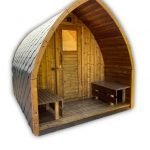 Best Seller! 15 % OFFOutdoor Wooden Sauna Pod – Iglu
Best Seller! 15 % OFFOutdoor Wooden Sauna Pod – IgluFrom: €5,415From: €4,551 -
 Garden Sauna Pod IgluFrom: €3,934
Garden Sauna Pod IgluFrom: €3,934 -
 Outdoor Sauna Scotland with Glass Front HobbitFrom: €6,680
Outdoor Sauna Scotland with Glass Front HobbitFrom: €6,680
Discover our other Outdoor Saunas Models
What is the outdoor sauna?
Saunas, dedicated spaces for relaxation and rejuvenation through heat therapy, exist in both indoor and outdoor variations, each sharing core principles but featuring distinctive characteristics.
While both indoor and outdoor saunas harness heat sources, sauna stones, and water to generate steam, a notable divergence lies in the prevalence of infrared saunas emitting dry heat, which are more commonly found indoors but increasingly available for outdoor use.
Crafted to withstand the vagaries of weather and temperature fluctuations, outdoor saunas employ specialized materials, setting them apart from their indoor counterparts. Beyond materials, several factors distinguish outdoor saunas:
- Diverse Designs: Unlike the standard box or cube shape prevalent in indoor saunas, outdoor saunas offer a broader spectrum of design options.
- Ventilation Ease: Outdoor saunas are generally easier to ventilate compared to their indoor counterparts. However, the installation process may be more intricate, necessitating adherence to local building codes, especially concerning wiring and chimney specifications.
- Size Disparities: Indoor saunas typically boast a more compact design, while outdoor saunas come in a range of sizes tailored to open-air settings.
Understanding these nuances is crucial when considering the installation and utilization of outdoor saunas, ensuring they harmonize with both personal preferences and the environment they inhabit.



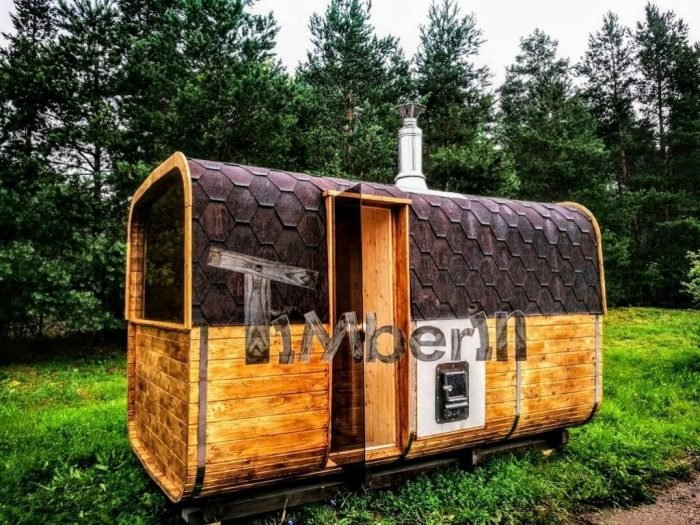








Exploring the World of Outdoor Saunas: Types and Features
- Traditional Finnish Saunas: The classic choice, Finnish saunas use dry heat generated by rocks on a stove. The wooden construction and high temperatures create a timeless and authentic sauna experience.
- Infrared Saunas: Utilizing infrared heaters, these saunas directly heat the body, offering a milder and more comfortable experience. They are known for their energy efficiency and ability to provide therapeutic benefits at lower temperatures.
- Barrel Saunas: Unique in design, barrel saunas offer a visually appealing and efficient use of space. The rounded shape allows for efficient heat circulation, creating a cozy atmosphere. Perfect for smaller outdoor spaces.
- Mobile and Portable Saunas: Ideal for those who desire flexibility, portable saunas can be easily set up and moved. They are a fantastic option for renters or individuals who want to explore different locations for their sauna experience.
Installation Tips for Your Outdoor Sauna
- Selecting the Right Location: Choose a level and well-drained spot for your outdoor sauna. Consider proximity to power sources, privacy, and the overall aesthetic of your outdoor space.
- Proper Foundation: A solid foundation is crucial for the stability and longevity of your sauna. Whether using concrete, gravel, or pre-made sauna pads, ensure a level surface.
- Electrical Considerations: Plan for the electrical requirements of your sauna stove. Consult with a qualified electrician to ensure safe and compliant installation.
- Ventilation and Insulation: Proper ventilation is essential to maintain a comfortable and safe sauna environment. Additionally, proper insulation ensures energy efficiency and temperature control.
Investing in an outdoor sauna is an investment in your well-being. From stress relief to improved skin health, the benefits are numerous. Whether you opt for the traditional charm of a Finnish sauna or the modern convenience of an infrared model, the key is to create a space that aligns with your lifestyle and enhances your overall sense of wellness. Follow the installation tips, explore the different types, and embark on a journey of relaxation and rejuvenation with your very own outdoor sauna retreat. Your path to wellness begins right in your backyard.
UNRAVELING THE ORIGINS OF OUTDOOR SAUNAS
The exact inception of outdoor saunas remains shrouded in mystery, with scholars suggesting a plausible commencement around 2,000 BCE in the northern reaches of Europe.
The earliest renditions of saunas likely resembled man-made caves, ingeniously sealed with water-resistant animal hides to thwart the intrusion of wind, snow, and rain.
Delving into the annals of ancient sauna history reveals fascinating insights:
- Health and Hygiene: Sauna rooms, with their enduring warmth and the sanitizing effects of smoke, became instrumental in enhancing the well-being and cleanliness of their occupants, contributing significantly to daily survival.
- Versatility of Use: Saunas from antiquity served multifaceted roles, functioning not only as spaces for relaxation but also doubling as birthing rooms, washrooms, kitchens, communal areas for festivities, and even makeshift mortuaries for preparing the deceased for burial.
- Adaptability as Dwellings: Beyond their utilitarian purposes, these saunas often doubled as homes due to their ability to retain warmth, increasing the likelihood of survival during harsh winter months.
- Sacred and Healing Significance: The therapeutic attributes of these ancient saunas elevated them to the status of sacred spaces, with some cultures attributing healing powers to sauna spirits. This belief in the magical properties of saunas persists in certain circles even today.
Piecing together the historical tapestry of outdoor saunas not only unveils their pragmatic origins but also underscores their cultural and spiritual significance across diverse civilizations.
The Health and Wellness Benefits of Garden Saunas
- Stress Reduction and Relaxation: Garden saunas provide a sanctuary for stress relief. The combination of heat, fresh air, and nature’s beauty creates an environment conducive to relaxation and mental rejuvenation.
- Detoxification and Skin Health: Sweating in the sauna aids in detoxification, flushing out impurities and promoting clearer, healthier skin. The increased blood circulation contributes to a radiant complexion.
- Improved Cardiovascular Health: Regular sauna sessions can have positive effects on cardiovascular health, promoting better blood circulation and potentially reducing the risk of certain cardiovascular conditions.
- Enhanced Sleep Quality: The relaxation induced by garden saunas can contribute to improved sleep quality. The gradual cooldown after a sauna session signals the body that it’s time to rest, leading to more restful nights.
VARIETIES OF OUTDOOR SAUNAS
Distinguishing factors among backyard saunas encompass three key elements:
- Heat Source
- Shape
- Size
HEAT SOURCE
Saunas generate heat through either traditional or “non-traditional” means, the latter involving infrared heaters. A closer look at these heat sources illuminates their workings:
TRADITIONAL SAUNA
Traditional saunas, also known as “wet saunas” or “steam saunas,” closely emulate the ancient sauna concept. Here’s how this type operates:
- Place sauna stones atop the heater for warming.
- Once hot, sprinkle water on the stones to create steam.
- The steam circulates, elevating the room temperature and inducing perspiration.
Many outdoor sauna enthusiasts favor the traditional option for its authentic ambiance. Modern iterations of traditional saunas offer dual heating methods: a wood-burning heater for an authentic experience or an electric heater.
- WOOD BURNING STOVE
Saunas equipped with a wood-burning stove utilize firewood to heat the rocks, enveloping users in a fragrant atmosphere. This sauna type requires no wiring but mandates the installation of a chimney.
In saunas with electric heaters, the rocks are heated using electricity. This is the standard choice in Almost Heaven Saunas, offering faster heating times and temperature control.
INFRARED SAUNA
Infrared saunas adopt a more targeted, contemporary approach to heat therapy. Instead of heating the entire room like traditional saunas, infrared saunas generate radiant heat through infrared heaters. Though the room temperature may not be as high, the body absorbs the radiant heat, prompting perspiration. Infrared saunas are proven to be seven times more effective than traditional saunas in detoxifying the body.
SAUNA VARIETY
Whether you seek a quaint, rustic sauna to infuse your yard with a cottage-like charm or a modern, stylish retreat, a myriad of distinctive styles awaits your selection for your new sauna.
BARREL SAUNA
The barrel sauna stands out with its exceptional circular design, delivering both aesthetics and functionality:
- Natural water shedding enhances durability, ensuring longevity even in adverse weather conditions.
- While suitable for indoor use, barrel saunas truly shine as outdoor installations.
- Their rounded shape facilitates quicker heating times and superior air circulation.
- For outdoor use, the barrel sauna arrives ready for installation, eliminating the need for additional insulation.
POD SAUNA
A newcomer to the sauna scene, the pod sauna introduces innovation and elegance:
- Showcasing an inventive rain-drop shape, the pod sauna adds a modern touch to your space.
- Its taller design provides users with added headspace, enhancing overall comfort.
- Optional chic overhang cove offers shelter for the entrance, adding a stylish element.
- Featuring a robust triple-layer roof, the pod sauna requires no extra insulation during installation.
CUBE SAUNA
Similar to the barrel sauna but with vertical walls, the cube sauna offers expanded interior space:
- Distinguished by vertical walls, the cube sauna maximizes interior roominess.
- Outdoor oval saunas boast an exceptionally wide front, setting them apart in design.
- Outdoor saunas integrated with a hot tub combine modernity with relaxation.
- Vertical up right built saunas designed for 2-4 persons.
- Modern saunas
Explore these diverse sauna styles, each offering a unique blend of aesthetics and functionality, ensuring your new sauna becomes a personalized oasis in your outdoor environment.
GARDEN SAUNAS: A PREFERRED CHOICE FOR ENHANCED WELLNESS
When deliberating between indoor and outdoor saunas, both options offer an array of health benefits, such as:
- Reduced blood pressure.
- Alleviated lung inflammation.
- Enhanced immune system against common colds and flu.
- Elimination of harmful toxins.
- Support for weight loss and management.
- Promotion of clearer, blemish-free skin.
- Stress relief and meditation opportunities.
While both indoor and outdoor saunas are commendable, opting for a garden sauna comes with distinct advantages:
- Space Optimization: Placing your sauna in the garden saves valuable indoor space, ensuring your living areas remain uncluttered.
- Aesthetic Appeal: An outdoor traditional sauna not only contributes to your well-being but also adds charm to your garden, potentially increasing your property’s value.
- Convenient Access: A strategically located sauna just outside your front door offers a quick retreat without the need to venture far from your property.
- Versatile Use: An outdoor sauna can double as a pool house, providing additional functionality. During winter, you can even enjoy quick dips in the pool between sauna sessions, making the most of your outdoor space.
In summary, the unique benefits of garden saunas make them an appealing choice, seamlessly blending wellness with aesthetics and practicality in your outdoor haven.
GARDEN SAUNA MAINTENANCE GUIDE
PRIOR TO EACH SAUNA SESSION
Maintaining the cleanliness of your garden sauna is crucial for a delightful and hygienic experience. Follow these steps before each session:
- Foot Cleaning: Wipe your feet before entering the sauna to minimize dirt and sweat accumulation, reducing the risk of mold growth inside.
- Pre-Sauna Shower: Take a quick shower before your sauna session to minimize the transfer of dirt, sweat, and grime onto benches and floors.
CLEANING YOUR GARDEN SAUNA
Regular cleaning ensures a pristine environment within your garden sauna. Adopt these practices:
- Routine Cleaning: Vacuum or sweep your sauna regularly, complemented by deeper cleaning at least once a month. Always turn off the sauna before cleaning to avoid exposure to higher temperatures.
- Chemical-Free Approach: Use chemical-free products and warm water for a safe and effective cleaning process. A mixture of baking soda and water is a natural and efficient cleaning agent. For stubborn stains, employ fine-grit sandpaper.
- Pressure Washing: If needed, pressure wash the sauna’s interior with a wide-patterned nozzle set to low pressure.
CARING FOR THE WOODEN INTERIOR OF YOUR GARDEN SAUNA
Preserving the integrity of the wooden interior is essential for long-lasting beauty. Consider the following:
- Water Quality: Avoid hard water to prevent lime buildup caused by magnesium and calcium salts. Use sanding discs for lime removal.
- Avoid Sealants: Refrain from using protectants or sealants inside the sauna, as heat can release toxic chemicals.
- Towel Usage: Always use towels during sessions, washing them promptly after each use.
- Regular Wiping: Wipe the wooden interior regularly with warm water and a soft cloth to maintain its appearance.
- Wood Touch-Ups: If the lumber warranty has expired and the wood appears faded, sand down those areas for a refreshed look.
CARING FOR THE WOODEN EXTERIOR OF YOUR GARDEN SAUNA
Extend your garden sauna’s life by tending to its exterior with care:
- Wood-Penetrating Oil: Treat the outside with a wood-penetrating oil for protection.
- Pressure Washing: For a thorough cleanse, use a low-pressure setting on a pressure washer.
- UV-Inhibiting Stain: If staining the exterior, choose a product with a UV inhibitor to shield the wood from sunlight.
What defines a barrel sauna in an outdoor garden setting?
A barrel sauna is a distinctive and chic personal sauna designed specifically for outdoor gardens. Providing both physical and mental health benefits, this stylish addition allows you to enjoy the sauna experience without leaving the comfort of your home.
Do outdoor barrel saunas heat up quickly?
Absolutely! The unique cylindrical design of an outdoor barrel sauna ensures a faster heating process, reaching the optimum temperature in just 45 minutes. This efficient heat-up time enhances the overall sauna experience.
How efficient is an outdoor barrel sauna?
The efficiency of an outdoor barrel sauna is attributed to its unique shape, requiring less energy to fill the room compared to its rectangular counterparts. This design ensures that the heat is concentrated where it’s enjoyed the most, providing a cost-effective and enjoyable sauna experience.
What are the benefits of having an outdoor garden sauna?
Outdoor garden saunas offer a plethora of benefits, including enhanced cardiovascular health, relief from muscle and joint pain, improved skin condition, and overall relaxation and stress reduction. The added bonus of enjoying a sauna amidst nature elevates the entire experience.
What materials are typically used for building outdoor garden saunas?
Outdoor garden saunas are commonly constructed from materials such as spruce, and Scandinavian Thermowood. These materials are chosen for their natural resistance to rot and decay, ensuring durability in outdoor settings.
How much does an outdoor garden sauna weigh?
The weight of an outdoor garden sauna varies, with the lightest sauna weighing approximately 500 kg and the heaviest reaching around 1500 kg and more. It’s crucial to factor in the weight of bathers when planning the foundation for the sauna.
What foundation is necessary for an outdoor garden sauna?
Selecting a site with a level, strong, and stable foundation is essential. Options include a deck or concrete pad, ensuring proper weight distribution, especially for larger saunas. Placing the sauna directly on the ground may require additional precautions, such as resting support cradles atop concrete pavers to prevent settling.
Can I build an outdoor garden sauna myself?
While building an outdoor garden sauna can be challenging for one person, it is feasible with proper planning and preparation. Understanding the necessary building materials, tools, and having a detailed construction plan is essential. Enlisting the help of friends is recommended for a smoother process.
Can I place the outdoor garden sauna on a deck?
Yes, placing a sauna on a deck is a wonderful option, providing aesthetics and convenience. Ensure that the deck is designed to support the sauna’s weight, and consider having it inspected by a qualified professional before installation.
Can I place my outdoor garden sauna directly on the ground?
Placing an outdoor garden sauna directly on the ground is generally not recommended due to potential moisture, rot, and pest issues. Optimal placement involves a solid foundation, such as a concrete pad or a deck. Considerations for drainage and potential damage from insects and small animals are essential for ground placement, with recommendations for the use of crushed gravel or stones.
Do I need to clean the inside of my outdoor garden sauna?
Regular cleaning of the inside of your outdoor garden sauna is recommended to maintain hygiene and prevent bacteria or mold buildup. Use a mild cleaning solution with a damp cloth, ensuring the sauna stays dry after each use. Avoid using chemicals inside the sauna to prevent wood damage and inhalation of harmful substances.
How do I clean the outside of my outdoor garden sauna?
To clean the exterior, use a mild cleaning solution with a soft brush or cloth. Avoid abrasive materials and harsh chemicals to protect the sauna’s surface. Sweeping away loose debris, such as leaves, and thorough rinsing with water will maintain the sauna’s appearance and integrity.
How often do I need to treat the exterior of my outdoor garden sauna?
The frequency of re-staining depends on wood type, climate, and usage. Cedar saunas may need re-application every 2 to 3 years, while other woods may require re-application every 3 to 5 years. Factors like climate and usage frequency can influence the need for more frequent treatments.
I’m noticing water coming into my sauna. What should I do?
Minor water seepage is normal, but substantial seepage may indicate loose bands. Regularly check and retighten bands if needed. Adding shingles to the roof enhances water resistance and sauna longevity.
How do I prevent mold in my sauna?
Preventing mold involves keeping the sauna dry, using a dehumidifier if necessary, regular cleaning, checking for leaks, and promptly treating existing mold with safe solutions. Mold can be harmful, so addressing issues promptly is crucial.
Can I hook up my own heater?
Electrical wiring must be done by a qualified electrician. Obtain quotes from multiple licensed electricians before installation to ensure compliance with local codes and regulations.
What are the electrical requirements for an electric sauna heater?
An electric sauna heater typically requires a dedicated circuit with 220-240V (single phase) or 380V (3-phase) and 30-50 amps. Consult specific heater instructions and have a licensed electrician perform the installation.
How hot will my sauna get?
Sauna temperatures typically range between 70C and 88C, with electric heaters reaching a maximum of 90C and wood-fired stoves exceeding 93C.
How quickly will my sauna get to the desired temperature?
Heating time varies based on sauna size, desired temperature, and heating system. On average, it takes 30 minutes to 1 hour for an outdoor sauna to reach the desired temperature.
How much does it cost to run an electric sauna heater?
Costs depend on sauna size, heating system, electricity rates, and usage. On average, it can cost from a few cents to several EUR per hour. Calculate based on heater wattage, local electricity rates, and usage habits for a more accurate estimate.
Can I pour water on the rocks in the heater?
Yes, our heaters are designed for wet/dry use. Pour water on the rocks to create a steam-filled environment. However, avoid overdoing it; pour only as much water as can easily evaporate. Electric heaters should not have water poured directly onto them.
Can a sauna be delivered flat-packed for self-assembly?
Absolutely. Most sauna models are available unassembled, making them ideal for challenging access locations. Flat-packed saunas not only facilitate self-assembly but also reduce shipping costs.
Which heater type heats the sauna faster: electric or wood-burning?
Heating time doesn’t significantly differ. The key distinction lies in the preparation process – electric heaters start with a button push, while wood-burning heaters require time to start a fire and post-use cleaning.
What is the best temperature for a sauna?
Individual preference varies, but for safety, keeping the temperature below 90˚C is recommended, especially for those with heart conditions. Sauna-goers should stay well-hydrated, and it’s crucial to know personal limits and avoid prolonged sauna sessions.
How many people can fit inside a sauna?
Bench space usually accommodates one person per meter, while the sauna room allows for two people per meter. For example, a 2-meter sauna comfortably fits 4 people. If planning to lay on benches, ensure a bench length of approximately 2 meters for one person.
Do I need to oil the exterior of the sauna?
It’s advisable to oil all exterior parts twice a year, preferably before and after winter. Assembled saunas are delivered pre-oiled, while flat-packed saunas require oiling after assembly.
Can I paint or stain the exterior of the sauna?
Certainly. All exterior parts are paintable or stainable with products designed for outdoor use, allowing customization according to personal preference.
What sort of foundation should I prepare for the sauna?
The foundation’s length and width should match the sauna size, ensuring a flat surface to prevent deformations. Upon request, we provide the required base drawing for the sauna.
What is the weight of the sauna?
Weight varies based on wood type and sauna length. Thermo wood is the lightest, while larch is the heaviest. As a rough estimate, a 2-meter sauna weighs under 1 tonne, with increasing weight corresponding to sauna length.
Which wood type is best for a humid climate?
Thermo wood, derived from spruce, is ideal for humid climates. It resists rot and warping due to burned water capillaries during the thermo wood preparation process.
Will the roof of the sauna withstand heavy snowfall?
Our Igloo model is recommended for mountainous areas with heavy snowfall. Its sloped roof is specifically designed to endure and resist snow build-up, ensuring durability and safety.
Will sauna stones be included?
Yes, every wood-burning or electric heater comes with the necessary quantity of sauna stones. You can enjoy the authentic sauna experience with the stones provided.
What heaters do we offer for outdoor saunas?
We provide a range of heating options, including electric, wood-fired, and smart APP-controlled pellet stoves. Each sauna model offers the flexibility to choose the heating method that suits your preferences.
How to avoid wood shrinkage in the sauna?
To prevent wood shrinkage and maintain the sauna’s integrity, consider placing buckets filled with water inside to address interior dryness. Additionally, periodically water the exterior by pouring a couple of buckets on the walls, minimizing the risk of deformation and cracks.
What is the delivery process and cost for our products?
The delivery price is additional and depends on factors such as model, size, assembly preference (pre-assembled or flat-packed), and delivery address.
How do I decide where to place my outdoor barrel sauna?
Follow two simple rules: firm and flat. Your sauna can be placed on a deck, concrete, paved stones, pressed gravel, etc. The molded cradle supports provided with our barrel saunas protect against moisture when placed directly on the ground.
Why is a traditional sauna experience considered good for your health?
The traditional sauna experience offers various health benefits, including improved circulation, lower blood pressure, enhanced immune system, respiratory relief, detoxification, calorie burning, improved skin tone, and relief from joint and muscle pain.
How is a traditional sauna experience different from an infrared one?
A traditional sauna generates steam with water, providing the benefits of heat exposure. Infrared, on the other hand, penetrates the body with infrared rays at lower temperatures, offering relief for sore joints and muscles. While both have benefits, the infrared experience is technically referred to as an “infrared therapy room.
Does a barrel sauna need a vent?
Yes, a vent underneath or near the heater is essential for fresh air intake. The vacuum created by the heater pulling hot air up requires a high vent for air to escape, ensuring proper circulation.
How do you maintain a barrel sauna?
Annually, check sauna stones, power wash the exterior (for outdoor models), inspect for loose parts or wear, sand down benches and stains, and assess weathered spots if stained.
What are the pros and cons of a barrel sauna?
The curved design may aid faster heating, but debates exist. While stylish, barrel saunas lack insulation, can be expensive, and demand maintenance.
Do barrel saunas leak in the rain?
Yes, barrel saunas may develop leaks, especially in harsh weather. Installing roofing materials like sauna shingles effectively prevents rain leaks.
Electric vs. wood fired sauna heaters
Electric Saunas:
Convenience: Easily controlled with a button touch.
Quick Heating: Rapidly reaches desired temperatures.
Indoor and Outdoor: Versatile for home and garden use.
Wood-Fired Saunas:
Authentic: Provides a traditional sauna experience.
Outdoor Ambiance: Ideal for gardens, adding rustic charm.
Sustainability: A more eco-friendly option.
Is it worth it to get an outdoor sauna?
The value depends on health benefits, convenience, privacy, cost savings, and property value enhancement. Assess what you seek from a sauna to determine its worth.
How long do outdoor saunas last?
Designed to last 10 or more years with proper care, regular maintenance is crucial for both the exterior and interior to maximize lifespan.
What should I look for in an outdoor sauna?
Choose a weatherproof sauna that withstands outdoor elements. Consider the benefits of electric and wood-burning heaters. Prioritize safety in its placement and use in an open environment.
Do outdoor saunas get moldy?
Traditional saunas with higher temperatures and steam increase moisture levels, posing a risk of mold. Ensure good ventilation and proper airing after each use to prevent mold buildup.
Do you need a drain in an outdoor sauna?
Most residential saunas don’t require a drain. Commercial saunas with more excess water may benefit from a drain for cleaning purposes, especially if using a hose.
What is the best shape for a sauna?
Saunas with round or curved shapes prevent air pockets. Barrel saunas with circular designs or ‘pod’ types with curved walls and roofs promote optimal air circulation.

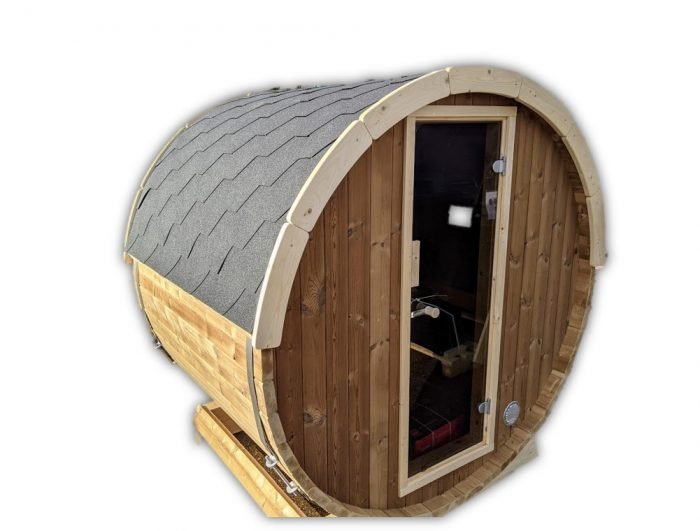
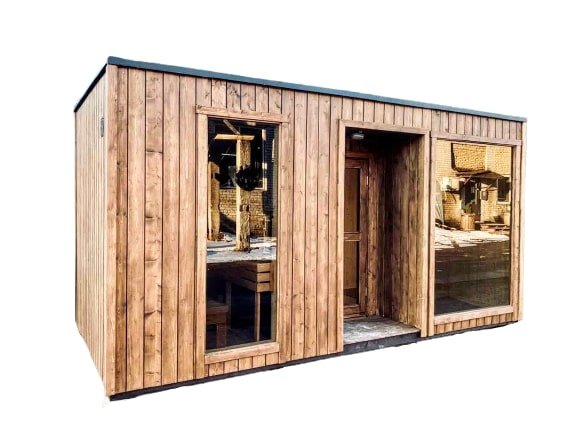

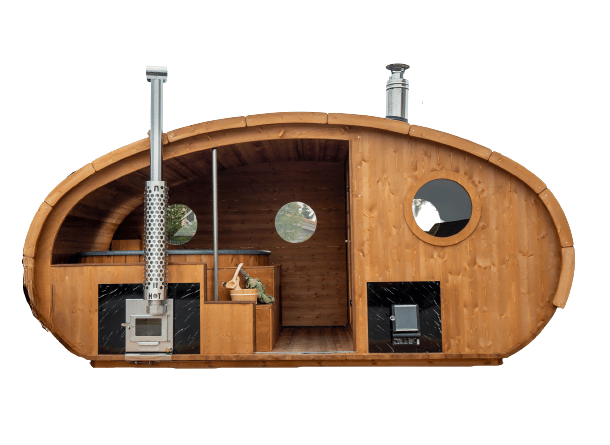
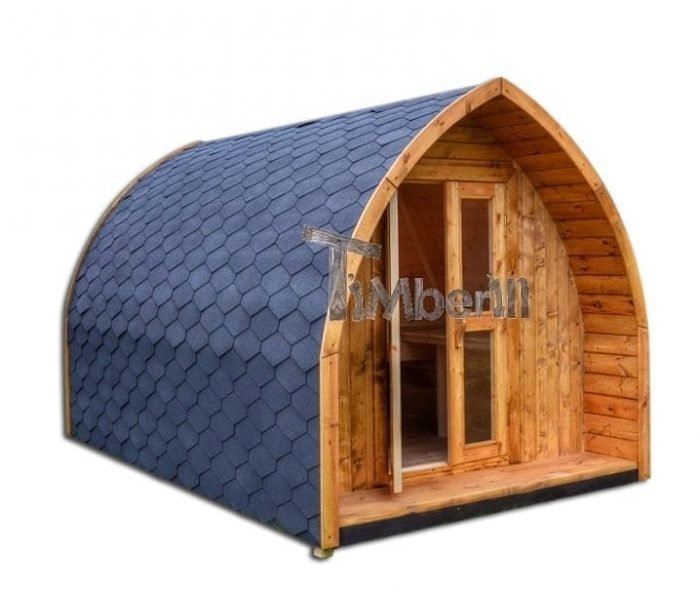


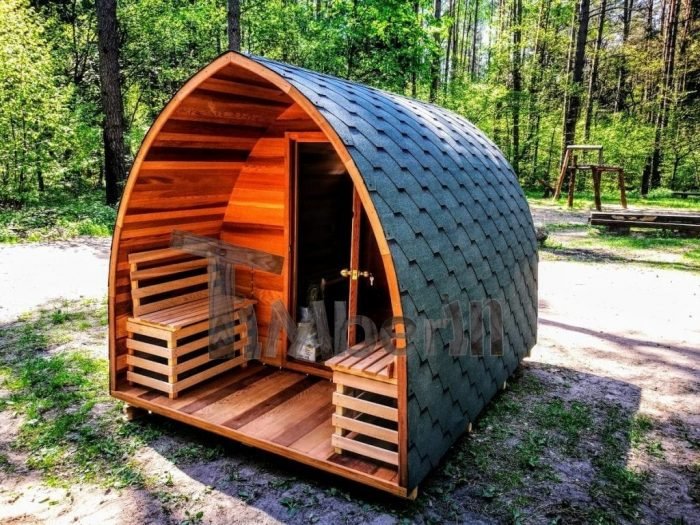

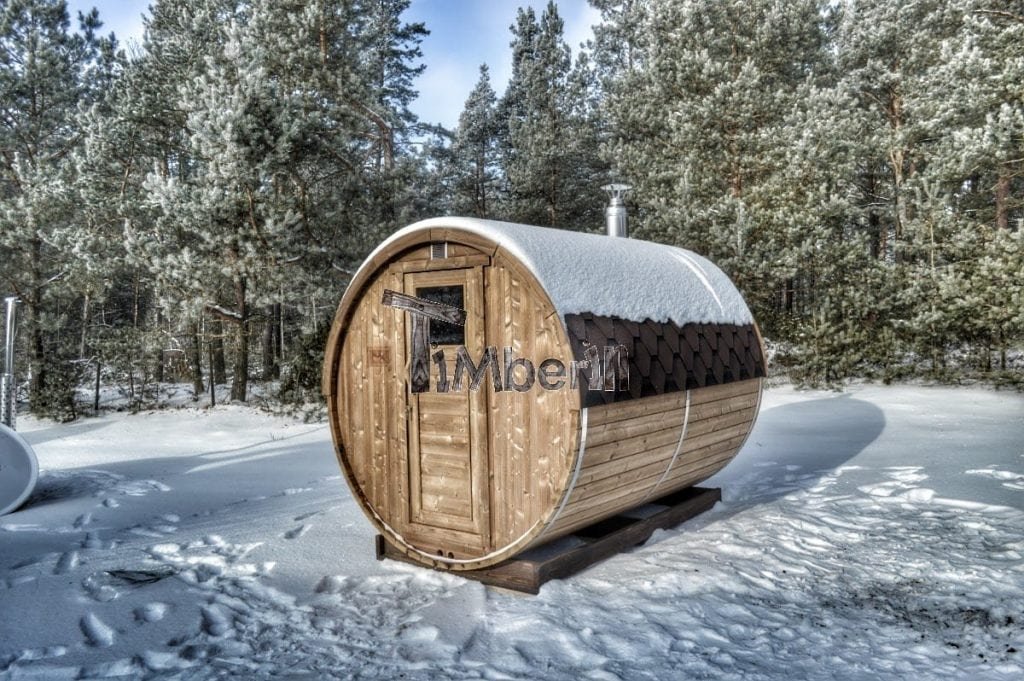


Thank you, quality is fantastic, service was also great. We are really happy with the sauna, it is very well made.
William / Nia
My Sauna arrived at the depot yesterday at 20.00 Hrs, the delay was mostly due to the illegal immigrants in Calais causing all trucks to be examined.
The sauna seems to be very well built, and is a very nice design with an interesting and appealing look to it. It may take a week or so to place in the spot I have for it, but I will send you pictures etc, when this is done.
Many Thanks to your team for their good work.
Hello, its Olivier from London. The sauna is great, I am just going to modify it a bit. I am going to make the place where you sit higher to get more steam access. I will make other better pictures and will send soon.
Regards